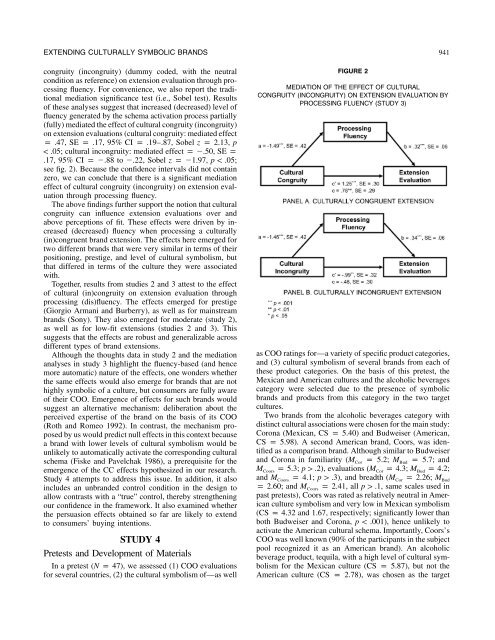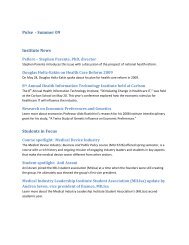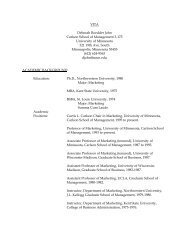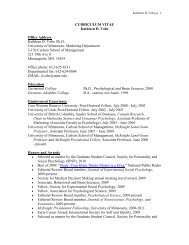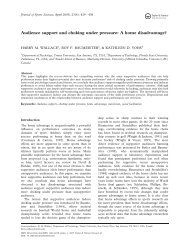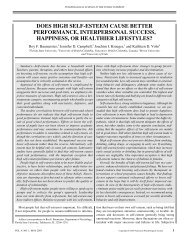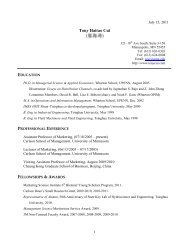Extending Culturally Symbolic Brands - Carlson School of ...
Extending Culturally Symbolic Brands - Carlson School of ...
Extending Culturally Symbolic Brands - Carlson School of ...
Create successful ePaper yourself
Turn your PDF publications into a flip-book with our unique Google optimized e-Paper software.
EXTENDING CULTURALLY SYMBOLIC BRANDS 941<br />
congruity (incongruity) (dummy coded, with the neutral<br />
condition as reference) on extension evaluation through processing<br />
fluency. For convenience, we also report the traditional<br />
mediation significance test (i.e., Sobel test). Results<br />
<strong>of</strong> these analyses suggest that increased (decreased) level <strong>of</strong><br />
fluency generated by the schema activation process partially<br />
(fully) mediated the effect <strong>of</strong> cultural congruity (incongruity)<br />
on extension evaluations (cultural congruity: mediated effect<br />
p .47, SE p .17, 95% CI p .19–.87, Sobel z p 2.13, p<br />
! .05; cultural incongruity: mediated effect p .50, SE p<br />
.17, 95% CI p .88 to .22, Sobel z p 1.97, p ! .05;<br />
see fig. 2). Because the confidence intervals did not contain<br />
zero, we can conclude that there is a significant mediation<br />
effect <strong>of</strong> cultural congruity (incongruity) on extension evaluation<br />
through processing fluency.<br />
The above findings further support the notion that cultural<br />
congruity can influence extension evaluations over and<br />
above perceptions <strong>of</strong> fit. These effects were driven by increased<br />
(decreased) fluency when processing a culturally<br />
(in)congruent brand extension. The effects here emerged for<br />
two different brands that were very similar in terms <strong>of</strong> their<br />
positioning, prestige, and level <strong>of</strong> cultural symbolism, but<br />
that differed in terms <strong>of</strong> the culture they were associated<br />
with.<br />
Together, results from studies 2 and 3 attest to the effect<br />
<strong>of</strong> cultural (in)congruity on extension evaluation through<br />
processing (dis)fluency. The effects emerged for prestige<br />
(Giorgio Armani and Burberry), as well as for mainstream<br />
brands (Sony). They also emerged for moderate (study 2),<br />
as well as for low-fit extensions (studies 2 and 3). This<br />
suggests that the effects are robust and generalizable across<br />
different types <strong>of</strong> brand extensions.<br />
Although the thoughts data in study 2 and the mediation<br />
analyses in study 3 highlight the fluency-based (and hence<br />
more automatic) nature <strong>of</strong> the effects, one wonders whether<br />
the same effects would also emerge for brands that are not<br />
highly symbolic <strong>of</strong> a culture, but consumers are fully aware<br />
<strong>of</strong> their COO. Emergence <strong>of</strong> effects for such brands would<br />
suggest an alternative mechanism: deliberation about the<br />
perceived expertise <strong>of</strong> the brand on the basis <strong>of</strong> its COO<br />
(Roth and Romeo 1992). In contrast, the mechanism proposed<br />
by us would predict null effects in this context because<br />
a brand with lower levels <strong>of</strong> cultural symbolism would be<br />
unlikely to automatically activate the corresponding cultural<br />
schema (Fiske and Pavelchak 1986), a prerequisite for the<br />
emergence <strong>of</strong> the CC effects hypothesized in our research.<br />
Study 4 attempts to address this issue. In addition, it also<br />
includes an unbranded control condition in the design to<br />
allow contrasts with a “true” control, thereby strengthening<br />
our confidence in the framework. It also examined whether<br />
the persuasion effects obtained so far are likely to extend<br />
to consumers’ buying intentions.<br />
STUDY 4<br />
Pretests and Development <strong>of</strong> Materials<br />
In a pretest (N p 47), we assessed (1) COO evaluations<br />
for several countries, (2) the cultural symbolism <strong>of</strong>—as well<br />
FIGURE 2<br />
MEDIATION OF THE EFFECT OF CULTURAL<br />
CONGRUITY (INCONGRUITY) ON EXTENSION EVALUATION BY<br />
PROCESSING FLUENCY (STUDY 3)<br />
as COO ratings for—a variety <strong>of</strong> specific product categories,<br />
and (3) cultural symbolism <strong>of</strong> several brands from each <strong>of</strong><br />
these product categories. On the basis <strong>of</strong> this pretest, the<br />
Mexican and American cultures and the alcoholic beverages<br />
category were selected due to the presence <strong>of</strong> symbolic<br />
brands and products from this category in the two target<br />
cultures.<br />
Two brands from the alcoholic beverages category with<br />
distinct cultural associations were chosen for the main study:<br />
Corona (Mexican, CS p 5.40) and Budweiser (American,<br />
CS p 5.98). A second American brand, Coors, was identified<br />
as a comparison brand. Although similar to Budweiser<br />
and Corona in familiarity (M Cor p 5.2; M Bud p 5.7; and<br />
M Coors p 5.3; p 1 .2), evaluations (M Cor p 4.3; M Bud p 4.2;<br />
and M Coors p 4.1; p 1 .3), and breadth (M Cor p 2.26; M Bud<br />
p 2.60; and M Coors p 2.41, all p 1 .1, same scales used in<br />
past pretests), Coors was rated as relatively neutral in American<br />
culture symbolism and very low in Mexican symbolism<br />
(CS p 4.32 and 1.67, respectively; significantly lower than<br />
both Budweiser and Corona, p ! .001), hence unlikely to<br />
activate the American cultural schema. Importantly, Coors’s<br />
COO was well known (90% <strong>of</strong> the participants in the subject<br />
pool recognized it as an American brand). An alcoholic<br />
beverage product, tequila, with a high level <strong>of</strong> cultural symbolism<br />
for the Mexican culture (CS p 5.87), but not the<br />
American culture (CS p 2.78), was chosen as the target


